Abstract
Purpose
To evaluate anatomical locations and distributions of supraorbital notch and foramen using facial 3D computed tomography in the Korean adult population.
Methods
The study sample was composed of 87 adult patients with no history of trauma or ocular disease. The horizontal position of the supraorbital foramen or notch was recorded in relation to a vertical line defined by a reproducible hypothetical point, such as the nasion and mid-maxilla and the midpoint of the horizontal supraorbital plane. The distance and angle for each supraorbital foramen and notch were calculated from the defined vertical line. Furthermore, vertical distance from supraorbital plane, which was established using the highest points of both supraorbital rims, was obtained from the supraorbital foramen.
Results
The mean age of the 87 patients was 45.44 ± 8.34 years (range, 30-59 years). There were 66 eyes in the supraorbital notch and 108 eyes in the supraorbital foramen. There were no distributional differences between the 2 sides. The mean horizontal distance of both types was 23.95 ± 3.93 mm (range, 16.41-38.94 mm). The horizontal distance of male patients was longer than the female patients (25.18 ± 4.16 mm vs. 22.63 ± 3.19 mm, p < 0.001, based on independent t-test) and the horizontal distance of supraorbital notch was shorter than the supraorbital foramen (22.59 ± 3.18 mm vs. 26.18 ± 4.04 mm, respectively, p < 0.001, based on independent t-test). The mean vertical distance and mean angles of the supraorbital foramen were 3.02 ± 1.119 mm and 6.81 ± 2.31 degrees (°), respectively.
Conclusions
The present study described the anatomical location of each supraorbital opening type in Korean adults. According to horizontal distance, a surgeon can avoid iatrogenic injury of the supraorbital neurovascular complex, especially during brow surgery. In addition, the anatomy can aid in targeting supraorbital neurovascular complex in cases of nerve block.
References
1. Booth AJ, Murray A, Tyers AG. The direct brow lift: efficacy, complications, and patient satisfaction. Br J Ophthalmol. 2004; 88:688–91.

2. Trivedi DJ, Shrimankar PS, Kariya VB, Pensi CA. A study of supraorbital notches and foramina in gujarati human skulls. NJIRM. 2010; 1:1–6.
3. Beer GM, Putz R, Mager K, et al. Variations of the frontal exit of the supraorbital nerve: an anatomic study. Plast Reconstr Surg. 1998; 102:334–41.

4. Barker L, Naveed H, Adds PJ, Uddin JM. Supraorbital notch and foramen: positional variation and relevance to direct brow lift. Ophthal Plast Reconstr Surg. 2013; 29:67–70.
5. Turhan-Haktanir N, Ayçiçek A, Haktanir A, Demir Y. Variations of supraorbital foramina in living subjects evaluated with multi-detector computed tomography. Head Neck. 2008; 30:1211–5.

6. Agthong S, Huanmanop T, Chentanez V. Anatomical variations of the supraorbital, infraorbital, and mental foramina related to gender and side. J Oral Maxillofac Surg. 2005; 63:800–4.

7. Webster RC, Gaunt JM, Hamdan US, et al. Supraorbital and supra-trochlear notches and foramina: anatomical variations and surgical relevance. Laryngoscope. 1986; 96:311–5.
8. Saylam C, Ozer MA, Ozek C, Gurler T. Anatomical variations of the frontal and supraorbital transcranial passages. J Craniofac Surg. 2003; 14:10–2.

9. McCord CD, Codner MA, Hester TR. Eyelid surgery: Principles and techniques. New York: Lippincott-Raven;1995. p. 166–95.
10. Ueda K, Harii K, Yamada A. Long-term follow-up study of brow-lift for treatment of facial paralysis. Ann Plast Surg. 1994; 32:166–70.

Figure 1.
Reference vertical line is defined as the line from reproducible 3 hypothetical points, such as nasion and mid-maxilla, and a midpoint of horizontal supraorbital plane. Horizontal distance is defined as the perpendicular distance from the reference vertical line in of the supraorbital foramen and supraorbital notch. Vertical distance is defined as the perpendicular distance from the supraorbital plane in the supraorbital foramen.
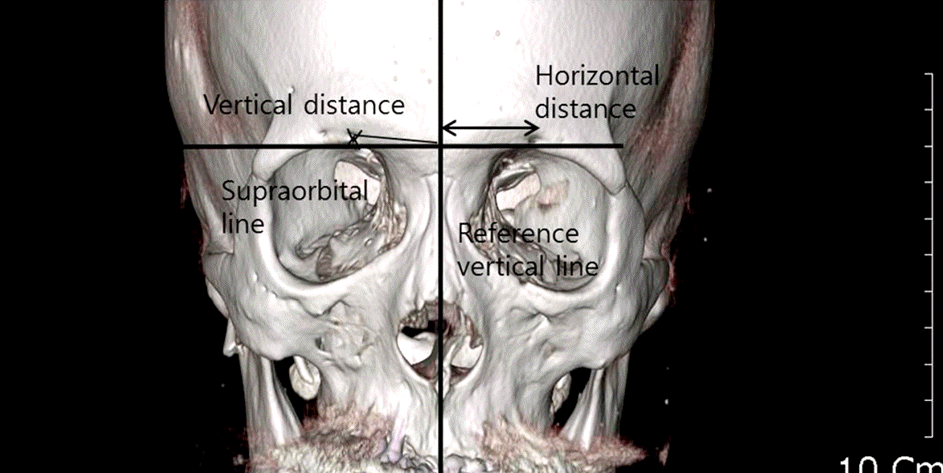
Figure 2.
There were 66 eyes (38%) in the supraorbital notch and 108 eyes (62%) in the supraorbital foramen.
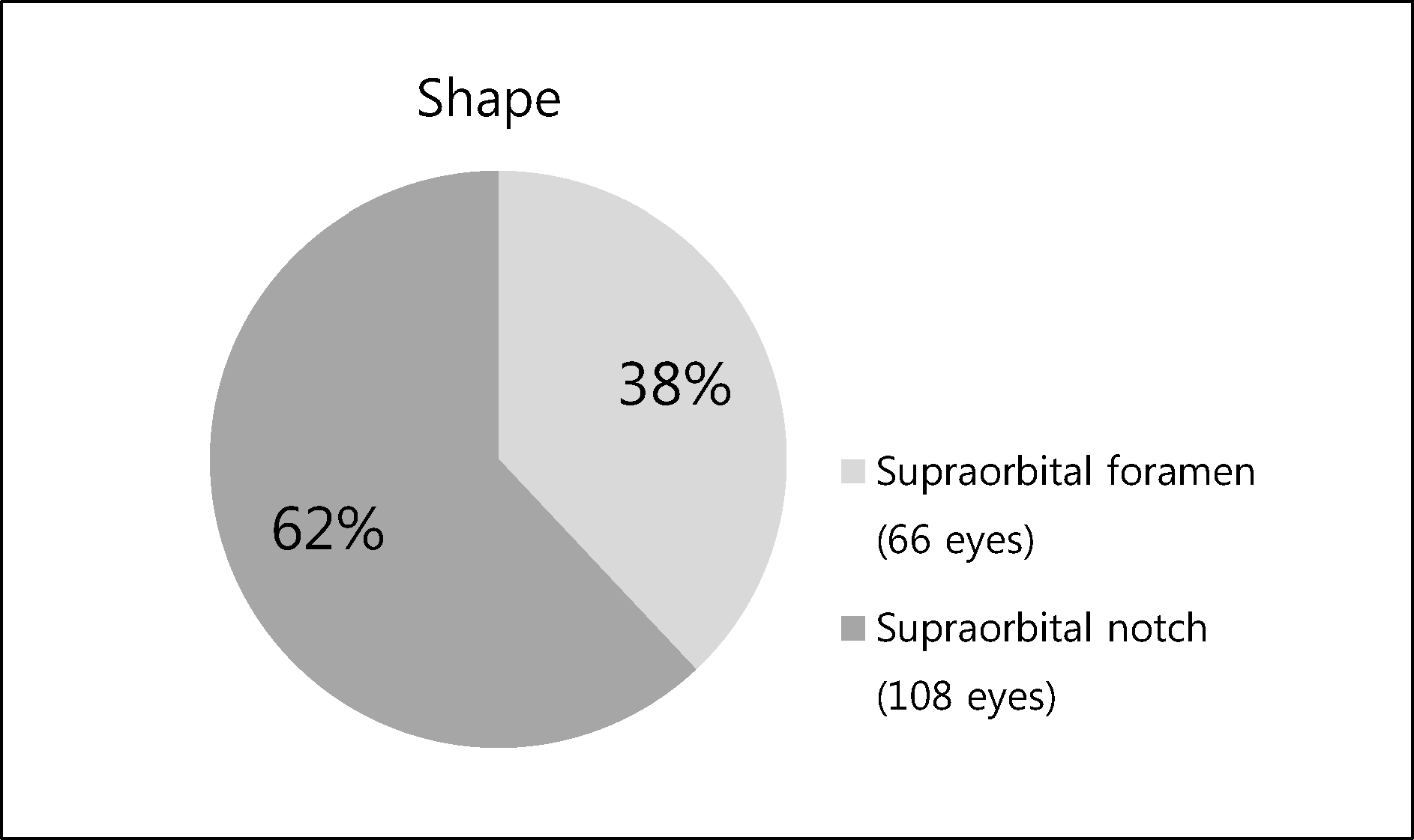
Figure 3.
There were 23 patients (26%) with both supraorbital foramens, 44 patients (51%) with both supraorbital notches, and 20 patients (26%) with one supraorbital notch and one supraorbital foramen.
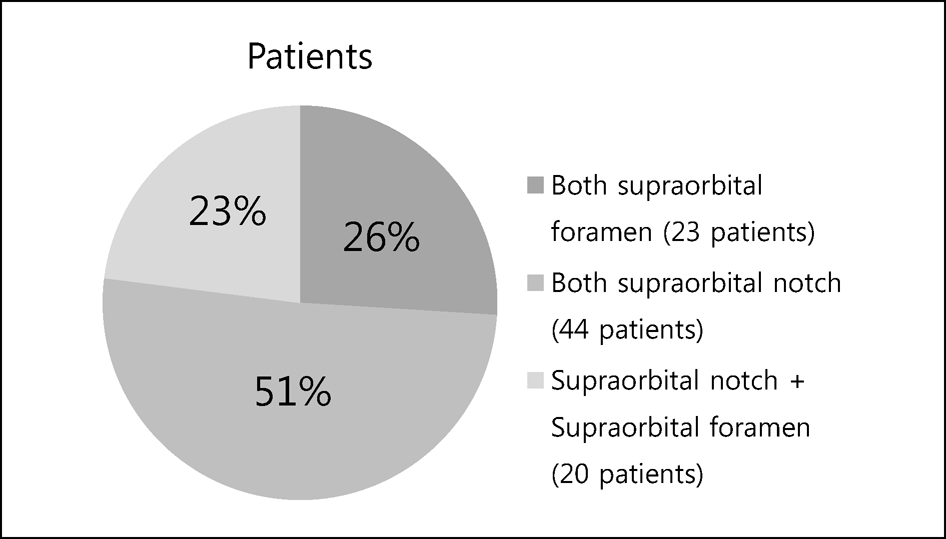
Figure 4.
The mean horizontal distance of males was 25.18 mm, and the standard deviation of horizontal distance was 4.16 mm.
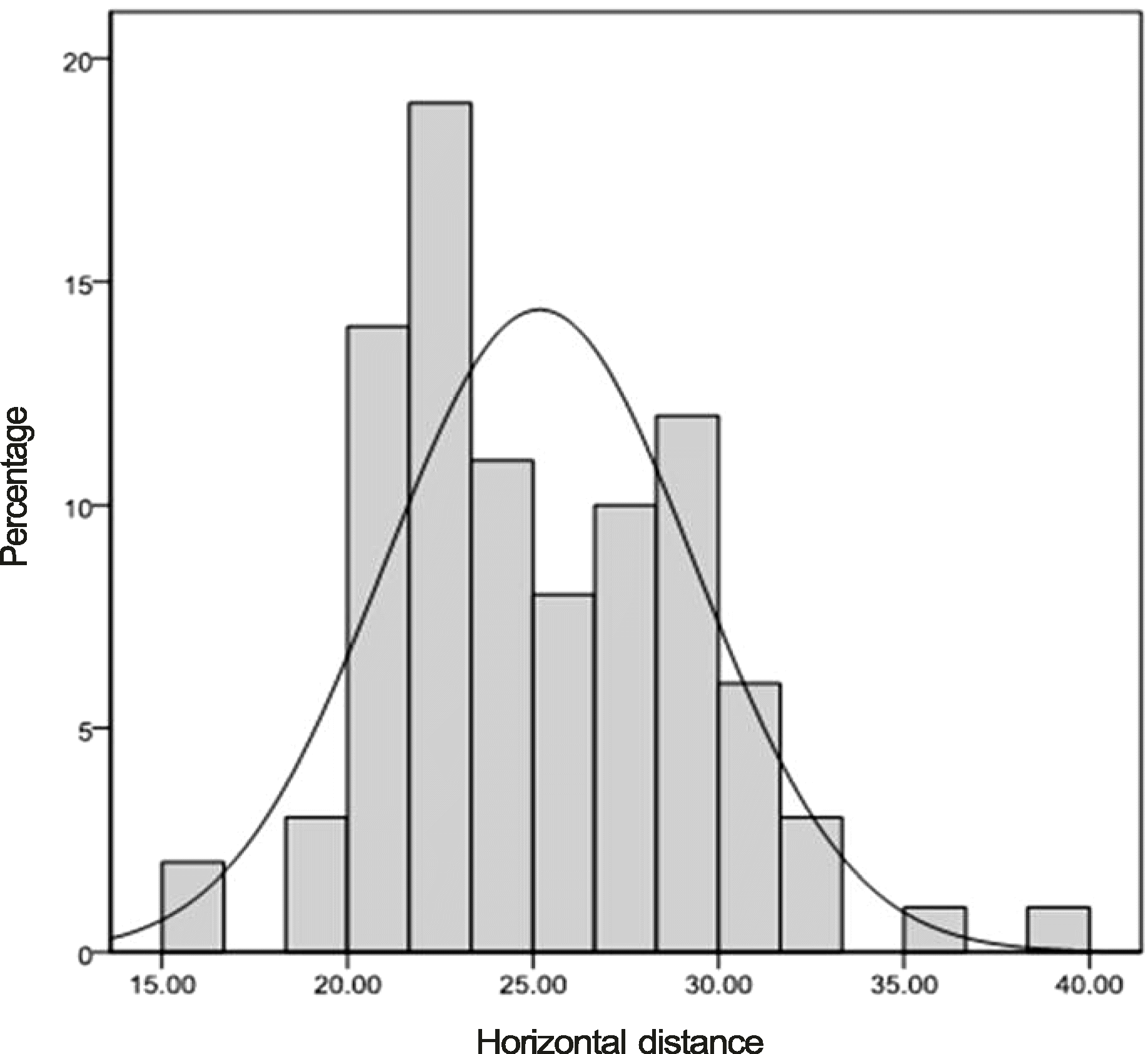
Figure 5.
The mean horizontal distance of female was 22.63 mm, and the standard deviation of horizontal distance was 3.20 mm.
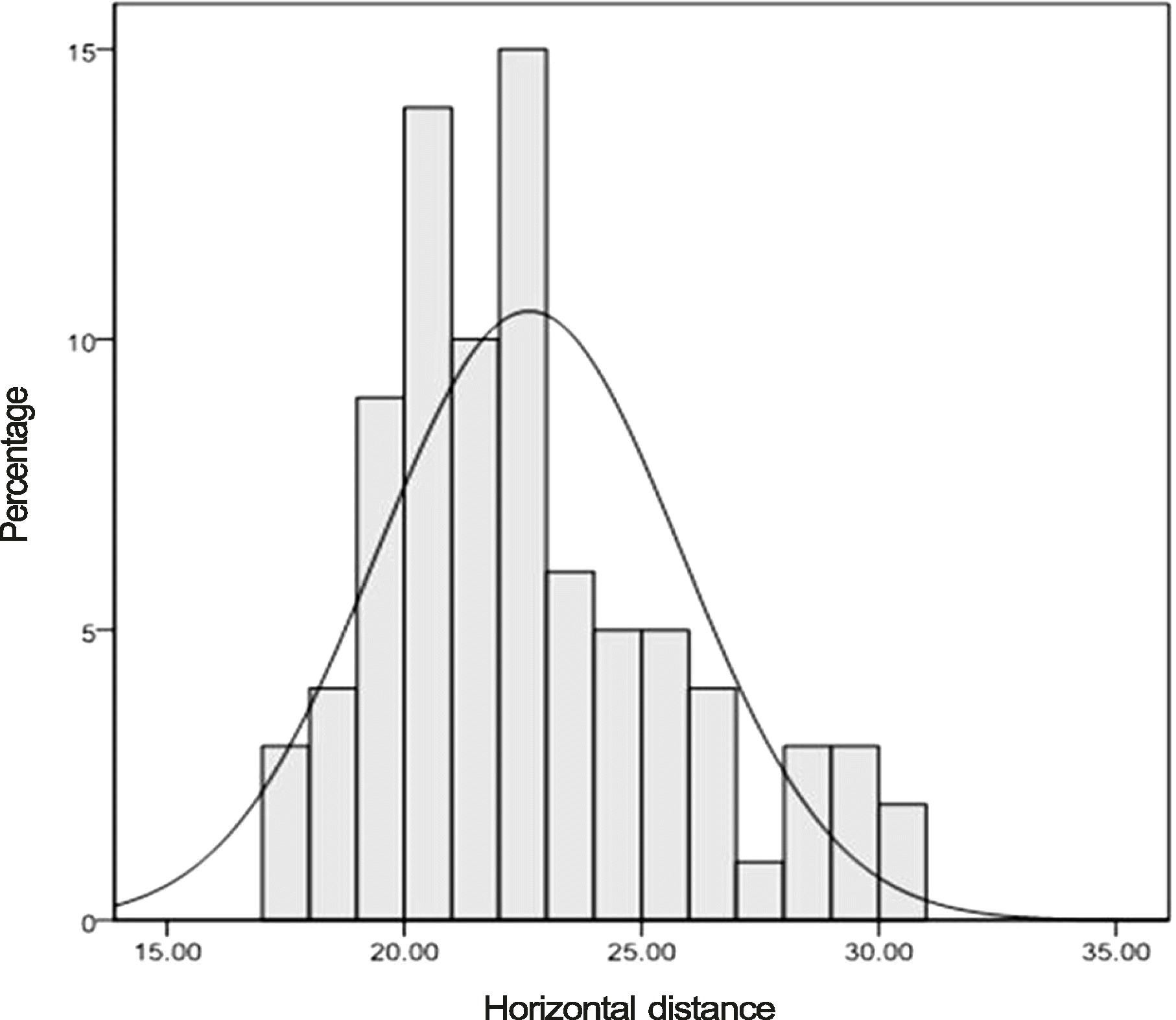
Table 1.
Comparison of shape distribution in each side
| Supraorbital notch | Supraorbital foramen | p-value∗ | |
|---|---|---|---|
| Right eye (no. of eyes, %) | 51 (58.6) | 36 (41.4) | 0.435 |
| Left eye (no. of eyes, %) | 57 (62.5) | 30 (34.5) |
Table 2.
Comparison of shape distribution according to sex
| Sex | Supraorbital notch | Supraorbital foramen | p-value∗ |
|---|---|---|---|
| Male (no. of eyes, %) | 52 (57.8) | 38 (42.2) | 0.274 |
| Female (no. of eyes, %) | 56 (66.7) | 28 (31.9) |
Table 3.
Comparison of horizontal distance with shape and sex
| Male (84 eyes) | Female (90 eyes) | p-value∗ | Total | |
|---|---|---|---|---|
| Supraorbital notch | 23.76 ± 3.38 (n = 52) | 21.51 ± 2.57 (n = 56) | <0.001 | 22.59 ± 3.18 (n = 108) |
| Supraorbital foramen | 27.13 ± 4.38 (n = 38) | 24.88 ± 3.18 (n = 28) | <0.001 | 26.18 ± 4.04 (n = 66) |
| p-value∗ | <0.001 | <0.001 | <0.001 | |
| Total | 25.18 ± 4.16 (n = 90) | 22.63 ± 3.19 (n = 84) | <0.001 |




 PDF
PDF ePub
ePub Citation
Citation Print
Print


 XML Download
XML Download